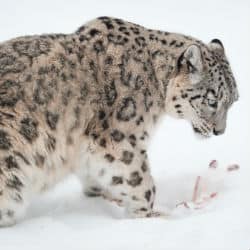Climate Change Will Force The Snow Leopard Into Extinction

Rising temperatures will result in a loss of habitat of the snow leopard which will adversely affect their fight against extinction a new report suggests. WWF says over a third of the species mountain living areas could become unsuitable for them to live as a result of climate change. The WWF report says that warmer temperatures means that plants and trees in those areas will not be able to survive. The report describes the snow leopard not only as being beautiful and enigmatic but also one of the most elusive and endangered of the big cats.
Multiple threats
According to WWF report the species faces a number of threats aside from climate change which include habitat fragmentation as humans encroach on areas where they live in the Eastern Himalayas. Another problem is a decline in the natural prey which forces snow leopards into attacking livestock which can result in locals killing them in retaliation. The illegal wildlife trade does not help either with the species being poached for its body parts.
All of these threats are exacerbated by climate change the report says which will add to the existing pressure on snow leopards reducing their numbers to levels which will not sustain maintainable populations in many areas.
“The Himalayas region will face a major crisis if we choose to ignore climate change. Not only do we risk losing majestic species such as the snow leopard, but hundreds of millions of people who rely on water flowing from these mountains may be affected,” WWF-UK’s Snow Leopard Programme Lead Rebecca May said.
Facts About The Snow Leopard
- Snow leopards live in the mountains of Central and South Asia. WWF estimates that there are between 4,000 to 6000 snow leopards left worldwide.
- The snow leopard is a solitary animal, typically they tend to hunt at dusk and dawn and have the ability to take down prey three times their body weight.
- Generally the snow leopard hunts wild animals but when they are unavailable will also feed on livestock.
- The spotted coat of the snow leopard changes with the seasons and goes from a thick white fur during winter which keeps them both warm and camouflaged to a fine yellow-grey coat in the summer.



